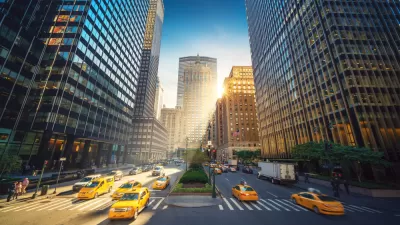The company is moving away from flashy new campuses in favor of converting existing buildings with interesting histories.

For years, tech giants have been building massive, new design-y headquarters, writes Nate Berg in Fast Company. “Increasingly though, Google is going a different route. Instead of solely building modern, amenity-rich campuses, the tech giant is putting more of its now-global real estate dollars into adaptively reusing old, significant, and interesting structures.”
In Los Angeles, an airplane hangar originally built by Howard Hughes for the construction of the Spruce Goose was bought by Google in the 2010s and converted into a 450,000-square-foot office complex. “Another project in Sunnyvale, California, is adapting a more recent piece of historic industrial architecture, turning a 1960s-era research and development facility of one of the first mainframe-computer makers into a 250,000-square-foot office building.”
“All this reuse is an office real estate strategy that makes a lot of sense in the hybrid work era coming out of the pandemic.” As Berg explains, “Bakker says making older buildings more energy efficient plays into Google’s sustainability goals, while also bolstering its environmental, social, and corporate governance (ESG) values. Doing so with very visible buildings and neighborhood projects becomes a form of marketing all on its own.”
FULL STORY: Google’s office strategy used to be new buildings. Now, it’s old warehouses

Maui's Vacation Rental Debate Turns Ugly
Verbal attacks, misinformation campaigns and fistfights plague a high-stakes debate to convert thousands of vacation rentals into long-term housing.

Planetizen Federal Action Tracker
A weekly monitor of how Trump’s orders and actions are impacting planners and planning in America.

San Francisco Suspends Traffic Calming Amidst Record Deaths
Citing “a challenging fiscal landscape,” the city will cease the program on the heels of 42 traffic deaths, including 24 pedestrians.

Defunct Pittsburgh Power Plant to Become Residential Tower
A decommissioned steam heat plant will be redeveloped into almost 100 affordable housing units.

Trump Prompts Restructuring of Transportation Research Board in “Unprecedented Overreach”
The TRB has eliminated more than half of its committees including those focused on climate, equity, and cities.

Amtrak Rolls Out New Orleans to Alabama “Mardi Gras” Train
The new service will operate morning and evening departures between Mobile and New Orleans.
Urban Design for Planners 1: Software Tools
This six-course series explores essential urban design concepts using open source software and equips planners with the tools they need to participate fully in the urban design process.
Planning for Universal Design
Learn the tools for implementing Universal Design in planning regulations.
Heyer Gruel & Associates PA
JM Goldson LLC
Custer County Colorado
City of Camden Redevelopment Agency
City of Astoria
Transportation Research & Education Center (TREC) at Portland State University
Jefferson Parish Government
Camden Redevelopment Agency
City of Claremont





























